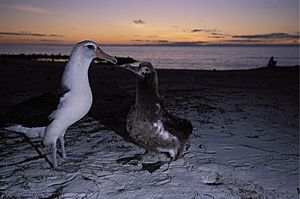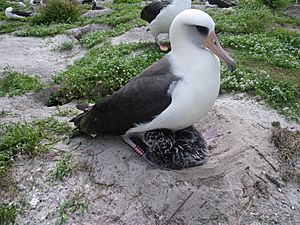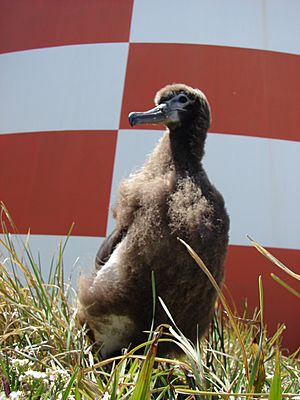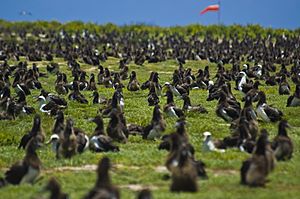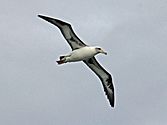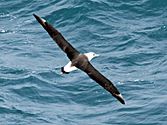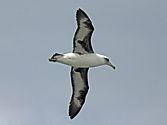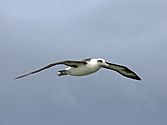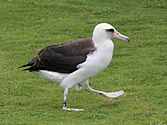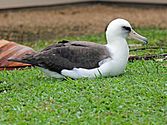Laysan albatross facts for kids
Quick facts for kids Laysan albatross |
|
|---|---|
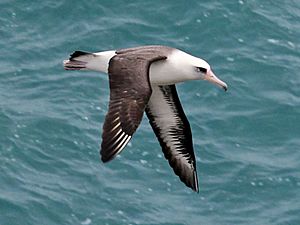 |
|
| Conservation status | |
| Scientific classification | |
| Genus: |
Phoebastria
|
| Species: |
immutabilis
|
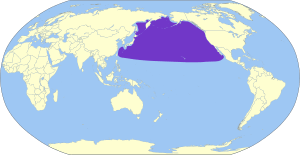 |
|
| Synonyms | |
|
Diomedea immutabilis |
|
The Laysan albatross (Phoebastria immutabilis) is a large seabird that lives across the North Pacific. Most of these birds, about 99.7%, make their home in the Northwestern Hawaiian Islands. This albatross is smaller than some of its relatives but looks a bit like a large gull. It is the second most common seabird in the Hawaiian Islands.
Scientists estimate there are about 2.5 million Laysan albatrosses. This bird is even starting to spread to new islands. The Laysan albatross was first officially described by Lionel Walter Rothschild in 1893. He named it Diomedea immutabilis after studying a bird from Laysan Island.
Contents
What's in a Name?
The Laysan albatross gets its name from Laysan, which is one of the islands where it breeds. Laysan Island is part of the Northwestern Hawaiian Islands.
Appearance and Features
The Laysan albatross is about 81 cm (32 in) long. Its wings can stretch very wide, from 195 to 203 cm (77–80 in). Male albatrosses are usually bigger than females. Males weigh between 2.4 to 4.1 kg (5.3–9.0 lb), while females weigh 1.9 to 3.6 kg (4.2–7.9 lb).
This albatross has a dark, blackish-gray color on its upper wings, back, and tail. Its head, lower back, and belly are white. It has a small black smudge around its eye. The pattern under its wings can look different on each bird. Some have thin black edges, and others have more black spots. Its bill is pink with a dark tip. Young albatrosses have a gray bill and a dark upper back. These birds do not change their feathers for breeding season.
It's usually easy to tell a Laysan albatross apart from other birds. In the North Pacific, the only other common albatross is the all-black black-footed albatross. The Laysan albatross is also smaller than the very rare short-tailed albatross and has a dark back. Its feathers look a bit like a gull's, with dark gray on top and white underneath.
Where They Live
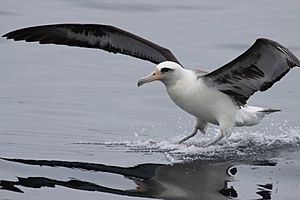
Laysan albatrosses live across a large area of the North Pacific Ocean. They have 16 places where they build their nests. Almost all of them, about 99.7%, nest in the Northwestern Hawaiian Islands. The islands of Midway and Laysan are especially important nesting spots.
Smaller groups of Laysan albatrosses also nest on the Bonin Islands near Japan. Recently, they have started to nest on islands off Mexico, like Guadalupe Island and others in the Revillagigedo Archipelago. When they are not nesting, these birds fly widely. They can be found from Japan all the way to the Bering Sea and as far south as 15°N latitude.
Behavior and Habits
The Laysan albatross is usually a quiet bird. But sometimes, you might hear it make long "moo"-like sounds, soft whinnies, or rattling noises. Female Laysan albatrosses can form strong bonds and stay together for life. They even work together to raise their young.
One famous female Laysan albatross named Wisdom is the oldest known wild bird in the Northern Hemisphere. Scientists put a band on Wisdom in 1956. In December 2016, she was seen raising a new chick on Midway Atoll. Laysan albatrosses don't start breeding until they are five years old. This means Wisdom was at least 66 years old in 2016!
Life Cycle and Reproduction
Laysan albatrosses nest in large groups, called colonies, on small islands and atolls. They often build many nests close together. Their nests can be simple scoops in the sand or more complex nests made from plants. They have a long breeding cycle and usually breed every year, though some birds might skip a year.
Young albatrosses return to the colony when they are three years old. However, they don't start mating until they are seven or eight years old. During these four or five years, they find a partner that they will stay with for life. Their courtship involves special "dances" with up to 25 different movements.
Sometimes, two female albatrosses will form a pair. This has been seen on the Hawaiian island of Oahu. On Oahu, there are more females than males, and about 31% of the pairs are female-female. These female pairs can successfully raise chicks if their eggs are fertilized by a male. This has helped conservation efforts in Hawaii. Researchers have swapped unfertilized eggs from female-female pairs with fertile eggs from nests in unsafe areas, like military airfields. The female-female pairs then hatch and raise these foster chicks.
The female lays a single, buff-white egg, which might have some spots. Both parents take turns sitting on the egg. The male usually starts the incubation. The egg hatches after about 65 days. After hatching, the parents spend several weeks brooding the chick. Then, both parents go out to sea to find food for their growing chick. It takes about 160 days for the chick to be ready to fly. This long time investment by the parents might be why they have such a long courtship. Both parents want to be sure the other is committed. The chicks are fed rich "stomach oil" and partly digested squid and fish that the parents bring back.
Laysan albatrosses and black-footed albatrosses have been known to hybridize, meaning they can have mixed-species chicks. Like all albatrosses, the Laysan albatross lives a long time. The oldest known wild bird, Wisdom, was at least 64 years old in 2015. In 2014, she hatched a healthy chick, which was believed to be her 36th. The longest confirmed lifespan for a wild seabird was a male albatross banded 53 years earlier.
What They Eat
The Laysan albatross mainly eats cephalopods, which are sea creatures like squid and octopuses. They also eat fish, crustaceans (like crabs and shrimp), and other small sea animals.
Protecting the Laysan Albatross
The IUCN first listed the Laysan albatross as vulnerable. This was because their numbers had dropped a lot. However, their population might be growing again. The IUCN now lists the Laysan albatross as "near threatened."
Even though the Laysan albatross is a common species, it has not fully recovered from hunting in the early 1900s. Feather hunters killed hundreds of thousands of these birds. They wiped them out from Wake Island and Johnston Atoll. This led to efforts to protect the species, which helped protect the Northwestern Hawaiian Islands.
Today, the Laysan albatross still faces threats. One big danger is longline fishing, where birds can get caught on fishing lines. They also eat floating plastics because of high rates of plastic pollution in the ocean. This can make them sick. On some newer nesting islands, Feral cats hunt nesting birds and chicks. In other places, big headed ants can harm young albatross chicks.
In 2006, scientists estimated there were about 1,180,000 adult Laysan albatrosses. Most of the breeding pairs, about 551,940, are found on Midway Atoll, Laysan Island, and the French Frigate Shoals. The Northwestern Hawaiian Islands saw a 32% drop in breeding birds from 1992 to 2002. But in recent years, the numbers have become more stable. The Mexican population of albatrosses has been growing.
Midway Atoll Concerns
Thousands of Laysan albatrosses on Midway Atoll are dying each year from lead poisoning. Midway Atoll is part of the Papahānaumokuākea Marine National Monument. The Laysan albatross is listed as vulnerable to extinction. It is also a special species on the Midway Atoll National Wildlife Refuge.
Chicks that hatch near old buildings left by the Navy are eating chips of lead-based paint. This causes very high levels of lead in their blood. It leads to serious brain problems and eventually death. As many as 10,000 chicks, or 5% of all hatched chicks, might die each year from lead paint. Many chicks nesting within 5 meters of buildings get a condition called "droop wing." This means they can't lift their wings, which drag on the ground. This causes broken bones and open sores. Chicks with droop wing can never fly and will die from hunger or thirst. Other chicks near buildings also get sick from lead. They have lead in their blood that harms their immune system, brain, and kidneys. This greatly lowers their chances of survival.
The United States Department of the Interior (DOI) estimates that $22.9 million is needed to clean up the lead paint on Midway Atoll. The 95 government buildings would need to have all lead paint removed. The sand around these old buildings would also need to be carefully cleaned to remove paint chips.
Gallery
-
At Kilauea Point on Kauai, Hawaii
See also
 In Spanish: Albatros de Laysan para niños
In Spanish: Albatros de Laysan para niños



